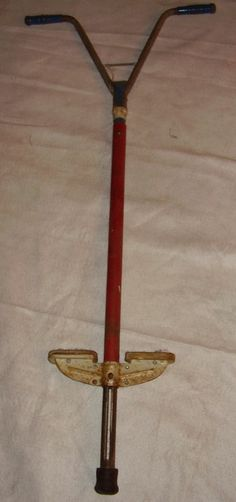The pogo stick is a fun, spring-loaded device that allows users to jump vertically while standing. Originally designed as a children’s toy, it has evolved into exercise equipment and a tool for extreme sports. The classic pogo stick consists of a pole with a handlebar at the top, footrests at the bottom, and a powerful spring positioned along the pole.
When using a pogo stick, riders place their feet on the footrests, bend their knees, and compress the spring. As the spring recoils, it propels the rider several inches or even feet into the air. By repeating this action, users can maintain a rhythmic bounce, making the pogo stick not only a fun toy but also a great workout for balance and coordination.
The Invention of the Pogo Stick: A Brief History

The origins of the pogo stick date back to the late 19th century. The early version of the device was patented in 1881 by George H. Herrington of Wichita, Kansas. This early model, known as a “spring stilt,” was designed for leaping long distances using springs attached to the feet.
The modern pogo stick, however, was invented by Max Pohlig and Ernst Gottschall from Germany. In March 1920, they filed a patent in Hanover for what they called the “spring end hopping stilt.” The name “pogo” is believed to come from the combination of the first two letters of their last names.
The two-handle design we know today was patented by George B. Hansburg in 1957. According to legend, the name “Pogo” came from a young Burmese girl named Pogo, whose father built a crude version of the device to help her cross muddy terrain on the way to a temple. Regardless of the folklore, the device continued to evolve, leading to improved designs like the Vurtego, Flybar, and BowGo, each enabling higher and safer jumps.
How Does a Pogo Stick Work? Exploring the Mechanics
The basic operation of a pogo stick involves balancing and jumping. Here’s how it works:
- Positioning: The rider stands on the footrests while holding the handlebars, positioning themselves directly over the spring.
- Compression and Recoil: By bending the knees and pushing downward, the rider compresses the spring. When released, the spring recoils, propelling the rider upwards.
- Steering: The pogo stick can also be steered by shifting weight to either side. By moving off the centerline of the spring, the user can create horizontal movement while bouncing vertically.
The more energy a rider applies to compress the spring, the higher they will bounce. This physics-based movement has made the pogo stick not only a popular toy but also an effective piece of exercise equipment and an adrenaline-pumping extreme sports device.
The Rise of Extreme Pogo (Xpogo)
The pogo stick has undergone a dramatic transformation in recent years, evolving into a key piece of equipment in the extreme sports world. Known as “Xpogo,” extreme pogo involves performing tricks and stunts while bouncing on high-performance pogo sticks. Unlike traditional pogo sticks, Xpogo sticks feature enhanced springs or even air-powered systems that allow athletes to reach heights of over 10 feet (3 meters).
Today, Xpogo is recognized as an official extreme sport, with a growing community of athletes and competitions worldwide. The sport has gained popularity through the following channels:
- Xpogo Athletes: Talented pogo enthusiasts perform jaw-dropping stunts, flips, and tricks at events and exhibitions.
- YouTube and Social Media: Xpogo athletes frequently share videos of their performances on platforms like YouTube, attracting millions of views and inspiring new generations of riders.
- Pogopalooza: This annual world championship of Xpogo brings together the best pogo athletes from around the globe to compete in freestyle, high jump, and other challenging events.
As Xpogo continues to grow, so does the design of the pogo sticks used in the sport, with models like the Vurtego, Flybar, and BowGo leading the way. These modern designs feature innovative springs and durable frames that can withstand the high impact of extreme jumping.
Popularity and World Records on the Pogo Stick

Over the years, the pogo stick has not only maintained its charm as a playful toy but also gained recognition in the world of records. Here are some impressive feats:
- Continuous Pogoing Record: James Roumeliotis holds the record for the longest continuous pogo session, lasting an incredible 20 hours and 13 minutes with 206,864 consecutive bounces.
- High Jumps: Modern Xpogo sticks have enabled athletes to achieve new heights, with records for the highest jump reaching over 11 feet.
- Pogo Weddings and Events: Pogo sticks have been used in unique ways, from weddings performed while bouncing to large-scale jumping contests that gather enthusiasts from around the world.
The pogo stick’s versatility makes it a hit at events, talent shows, and even workout routines. It’s a classic toy that has managed to stay relevant by adapting to modern trends, including fitness and extreme sports.
Benefits of Using a Pogo Stick: More Than Just Fun

While pogo sticks are widely associated with fun, they offer more than just entertainment. Here are some benefits of using a pogo stick:
- Improved Balance: Regular bouncing on a pogo stick requires balance, helping users enhance their core strength and stability.
- Cardio Workout: Pogoing is an effective cardiovascular exercise that raises the heart rate, promoting better endurance.
- Coordination: As users steer and balance on the pogo stick, they develop better hand-eye coordination and spatial awareness.
- Leg Strength: Bouncing repeatedly builds leg muscles, improving overall leg strength and agility.
Whether you’re using it as a fitness tool or trying to master a few tricks, the pogo stick offers a fun and effective way to stay active.
Conclusion: The Enduring Appeal of the Pogo Stick
From its early days as a simple toy to its modern role in the extreme sports arena, the pogo stick has proven to be a timeless invention. It combines fun, exercise, and skill-building, making it a hit among kids, fitness enthusiasts, and thrill-seekers alike. As the sport of Xpogo grows and new designs push the boundaries of what’s possible, the pogo stick’s legacy only continues to expand.
Whether you’re aiming to set a new record, learn a cool trick, or just have some bouncy fun, the pogo stick offers endless possibilities. So, why not give it a try?


